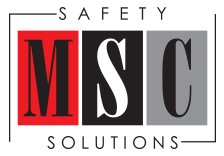Construction is an industry in which workplace safety is of paramount importance. According to the US Bureau of Labor Statistics, there are over 150,000 accidents reported for work-related injuries on construction sites every year. This means that one out of every 10 construction workers will be involved in an accident – and over 5,000 will be fatally injured on the job.
The task of reducing or eliminating these hazards can be overwhelming. At MSC Safety Solutions, we often receive questions asking:
- Where do I even begin with construction safety management?
- What are the most important safety rules in construction?
- How do you ensure OSHA compliance so you can meet safety standards?
- What are the most important aspects of safety training?
In order to create a safer worksite, you must first know where to start.
Construction sites are full of health and safety risks! There are dangerous tools all around, unstable foundations, scaffoldings, and makeshift walkways or steps, as well as heavy equipment which could cause serious injury if used improperly.
So, this begs the question: What are the top safety risks in construction?
Let’s discuss this.
1. Personal Safety Risks
First and foremost, anything that increases the risk of bodily injury to a worker should be addressed immediately.
According to a report from OSHA, the leading causes of death for construction workers are:
- Falls (33.5% of all fatalities)
- Being struck by a object or equipment (11.1%)
- Electrocution (8.5%)
- Being caught in-between equipment, objects, or crushed by structure (5.5%)
OSHA’s mission has always been to create safer workplaces by requiring employers to follow set guidelines and standards. Construction sites must also pass safety inspections to confirm that they are meeting all OSHA approved standards.
Unfortunately, many worksites violate these regulations, which puts their employees at risk. According to OSHA, the most common safety regulation violations on construction sites are:
- Fall protection violations
- Improper hazard communication standards
- Scaffolding and other general requirement violations
- Failure to provide adequate respiratory protection
- Lack of control of hazardous energy (lockout and tagout systems)
- Ladder safety violations
- Powered industrial truck violations
- Not meeting fall protection training requirements
- Machinery and machine guarding violations
- Failure to provide adequate eye and face protection
It is absolutely vital to tackle these major issues first to eliminate the most obvious safety hazards. Failing to meet OSHA regulations for these safety issues is unacceptable – and this makes it all the more important to ensure that your construction site is up to code.
It can be difficult to meet all of OSHA’s regulations if you are unfamiliar with their standards. Plus, OSHA is currently in the process of increasing safety standards to reduce fall and excavation relation hazards – meaning that there will be even more rules and regulations to follow. We recommend working with an MSCSS construction safety consultant who can assess your current situation and help you find solutions for OSHA compliance.
Further, it is imperative to offer safety training courses that cover all of the procedures to avoid potential hazards and ways to use PPE (personal protective equipment) correctly.
2. Equipment Usage Safety Risks
As stated from OSHA’s previously mentioned report, a combined total of 16.6% of all on-site injuries are directly related to the improper use of equipment, such as power tools or construction vehicles like cranes, bulldozers, excavators, and other heavy machinery.
Improper training or misuse of equipment is not just dangerous, but it can slow down progress and productivity, waste materials, and increase overhead costs in the long run. Of course, the use of heavy machinery is absolutely necessary on construction sites – so how can the safety of the workplace be improved when using this equipment?
First, only certified employees should operate machinery, and that operator needs to be certified for that specific type of equipment. This means that operators should complete crane operating training, rigging classes, onsite forklift training, or overhead crane training before using that type of machinery. It is also important that all of their training certifications are up to date, as some licenses do expire. If an unqualified operator uses equipment and causes an accident, it could not only be disastrous, but the fault would lie with the construction company.
All of the heavy equipment and power tools should be inspected frequently to identify signs of wear or other issues which could cause the equipment to malfunction. This can help to reduce the likelihood of any accidents.
3. Lack of On-Going Leadership Training
What should come as no shock, the biggest mistake that leads to workplace hazards is a lack of proper safety training. All too often, companies offer training when employees are first hired – and do not revisit it again. It is important to implement refresher courses and incorporate new standards and technology training as time goes on.
However, enforcing ongoing training can be quite a challenge. It is hard to set scheduled classroom times for everyone within an organization. Plus, due to COVID-19 restrictions, many classes are not being properly offered or have limited availability.
MSC Safety Solutions takes a number of measures to offer safe, in-person health and safety training courses to ensure all workers stay up-to-date on compliance.
Conclusion
Construction workers should not be afraid of putting their lives or health at risk. While not every single hazard can be eliminated, it is imperative that workplace safety solutions are properly implemented to reduce the risk of injury or harm whenever possible.
MSC Safety Solutions’ mission is to help provide comprehensive construction safety programs through both in-person and online training courses. We offer a variety of classes that cover all topics to ensure worksites are up to code and workers are properly trained on all aspects of construction safety.
Please reach out to us today to learn more about the courses we offer.




